Math and Logic Puzzles
If you REALLY like exercising your brain, figuring things 'round and 'round till you explode, then this is the page for you !
Whosoever shall solve these puzzles shall Rule The Universe!
... or at least they should ...

- Prodigy Math
- Prodigy English
- Is a Premium Membership Worth It?
- Promote a Growth Mindset
- Help Your Child Who's Struggling with Math
- Parent's Guide to Prodigy
- Back to School
- Assessments
- Math Curriculum Coverage
- English Curriculum Coverage
- Teacher Resource Center
- Administrators
- Game Portal
- Case Studies

20 Best Math Puzzles to Engage and Challenge Your Students
Written by Maria Kampen
- Teacher Resources

- 1. Math crossword puzzles
- 2. Math problem search
- 3. Math riddles
It’s time for math class, and your students are bored.
It might sound harsh, but it’s true -- less than half of 8th grade students report being engaged at school according to this Gallup survey , and engagement levels only drop as students get older.
Math puzzles are one of the best -- and oldest -- ways to encourage student engagement. Brain teasers, logic puzzles and math riddles give students challenges that encourage problem-solving and logical thinking. They can be used in classroom gamification , and to inspire students to tackle problems they might have previously seen as too difficult.
Math puzzles for kids

Puzzles to Print
Take a crossword, and make it math: that’s the basic concept behind this highly adaptable math challenge. Instead of words, students use numbers to complete the vertical and horizontal strips. Math crossword puzzles can be adapted to teach concepts like money, addition, or rounding numbers. Solutions can be the products of equations or numbers given by clues.
Have students practice their addition, subtraction, multiplication and division skills by searching for hidden math equations in a word search-style puzzle . It can be adapted to any skill you want students to practice, and promotes a solid understanding of basic math facts.
My PreCalc students love riddles... can you figure out where the other dollar went?? #MathRiddles pic.twitter.com/BclqW9nq98 — Rachel Frasier (@MsFrasierMHS) January 8, 2019
Do your students love word problems ? Try giving them some math riddles that combine critical thinking with basic math skills. Put one up on the board for students to think about before class begins, or hand them out as extra practice after they’ve finished their work.
Prodigy is an engaging, game-based platform that turns math into an adventure! While it’s not a math puzzle in the traditional sense, Prodigy uses many of the same principles to develop critical thinking skills and mathematical fluency.
Students complete standards-aligned math questions to earn coins, collect pets and go on quests. Teachers can deliver differentiated math content to each student, prep for standardized tests and easily analyze student achievement data with a free account.
See how it works below!
Make math an exciting adventure
Adaptive math practice meets engaging game-based learning with Prodigy Math. As students explore an exciting fantasy world, parents and teachers can support their learning and make it more effective than ever.
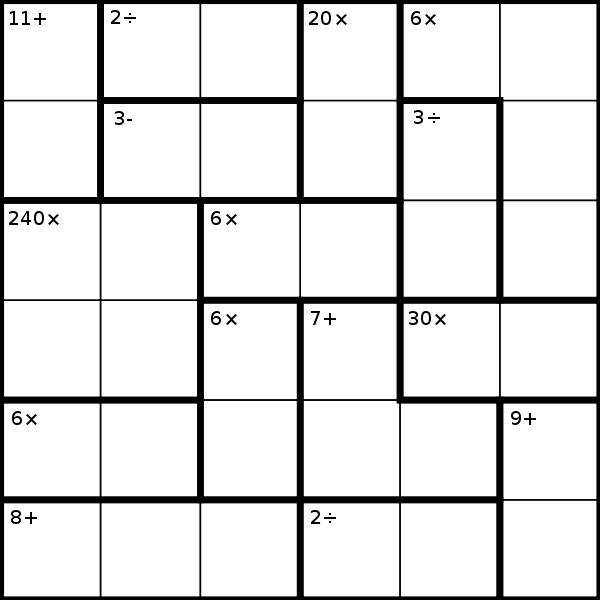
KenKenKenKen
is a “grid-based numerical puzzle” that looks like a combined number cross and sudoku grid. Invented in 2004 by a famous Japanese math instructor named Tetsuya Miyamoto, it is featured daily in The New York Times and other newspapers. It challenges students to practice their basic math skills while they apply logic and critical thinking skills to the problem.
6. Pre-algebraic puzzles
Pre-algebraic puzzles use fun substitutions to get students ready to perform basic functions and encourage them to build problem-solving skills. They promote abstract reasoning and challenge students to think critically about the problems in front of them. As an added bonus, students who suffer from math anxiety might find the lack of complicated equations reassuring, and be more willing to attempt a solution.
7. Domino puzzle board

Games 4 Gains
There are hundreds of ways to use dominoes in your math classroom, but this puzzle gives students a chance to practice addition and multiplication in a fun, hands-on way. You can have students work alone or in pairs to complete the puzzle.

This online game and app challenges players to slide numbered tiles around a grid until they reach 2048. It’s super fun and not as easy as it sounds, so consider sending it home with students or assigning it after the rest of the lesson is over. It encourages students to think strategically about their next move, and it’s a great tool for learning about exponents.

Math in English
Kakuro , also called “Cross Sums,” is another mathematical crossword puzzle. Players must use the numbers one through nine to reach “clues” on the outside of the row. Decrease the size of the grid to make it easier for younger players, or keep it as is for students who need a challenge. Students can combine addition and critical thinking and develop multiple skills with one fun challenge.
10. Magic square
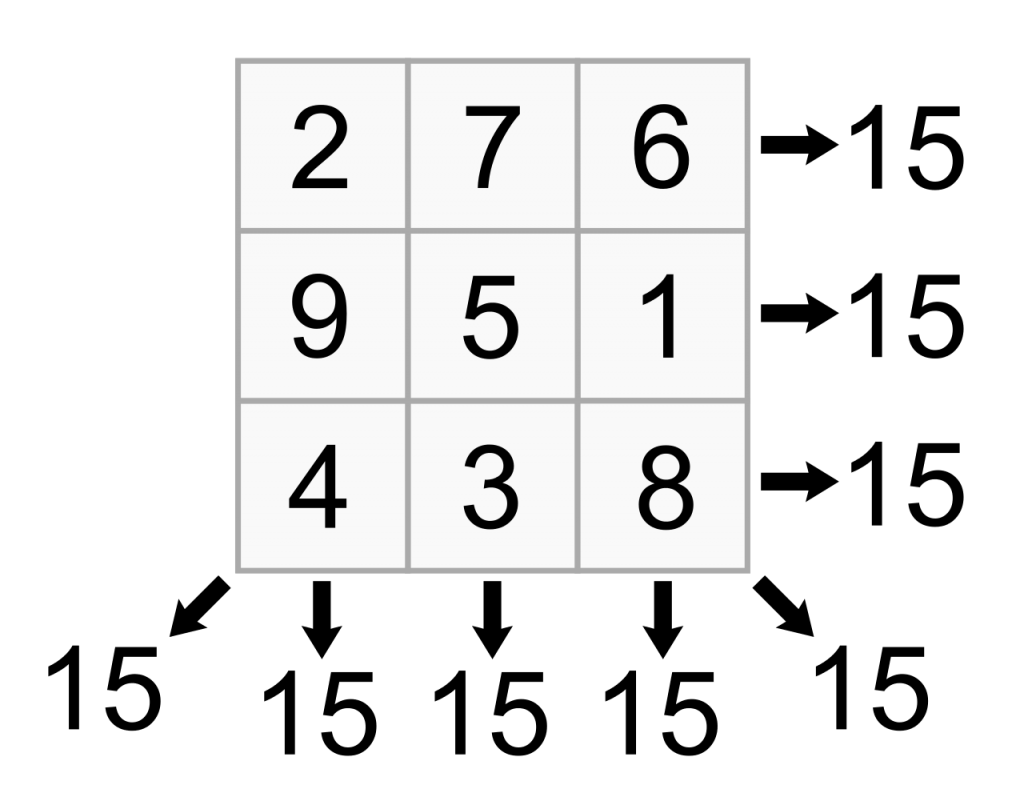
Magic squares have been around for thousands of years, and were introduced to Western civilization by translated Arabic texts during the Renaissance. While magic squares can be a variety of sizes, the three by three grid is the smallest possible version and is the most accessible for young students.
This is also a great math puzzle to try if your students are tactile learners. Using recycled bottle caps, label each with a number from one to nine. Have your students arrange them in a three by three square so that the sum of any three caps in a line (horizontally, vertically and diagonally) equals 15.
11. Perimeter magic triangle
This activity uses the same materials and concept as the magic square, but asks students to arrange the numbers one to six in a triangle where all three sides equal the same number. There are a few different solutions to this puzzle, so encourage students to see how many they can find.
Make learning fun, adaptive and insightful
There's no cost to you or your students and Prodigy is fully aligned with state standards for grades 1-8 math.
Sudoku is an excellent after-lesson activity that encourages logical thinking and problem solving. You’ve probably already played this classic puzzle, and it’s a great choice for your students. Sudoku puzzles appear in newspapers around the world every day, and there are hundreds of online resources that generate puzzles based on difficulty.
13. Flexagon
There’s a pretty good chance that by now, fidget spinners have infiltrated your classroom. If you want to counter that invasion, consider challenging your students to create flexagons. Flexagons are paper-folded objects that can be transformed into different shapes through pinching and folding, and will keep wandering fingers busy and focused on the wonders of geometry.
14. Turn the fish

This puzzle seems simple, but it just might stump your students. After setting up sticks in the required order, challenge them to make the fish swim in the other direction -- by moving just three matchsticks.
15. Join the dots

Cool Math 4 Kids
This puzzle challenges students to connect all the dots in a three by three grid using only four straight lines. While it may sound easy, chances are that it will take your class a while to come up with the solution. (Hint: it requires some “out of the box” thinking.)
16. Brain teasers
While they don’t always deal directly with math skills, brain teasers can be important tools in the development of a child’s critical thinking skills. Incorporate brain teasers into a classroom discussion, or use them as math journal prompts and challenge students to explain their thinking.
Bonus: For a discussion on probability introduce an older class to the Monty Hall Problem, one of the most controversial math logic problems of all time.
17. Tower of Hanoi
This interactive logic puzzle was invented by a French mathematician named Edouard Lucas in 1883. It even comes with an origin story: According to legend, there is a temple with three posts and 64 golden disks.
Priests move these disks in accordance with the rules of the game, in order to fulfill a prophecy that claims the world will end with the last move of the puzzle. But not to worry -- it’s going to take the priests about 585 billion years to finish, so you’ll be able to fit in the rest of your math class.
Starting with three disks stacked on top of each other, students must move all of the disks from the first to the third pole without stacking a larger disk on top of a smaller one. Older students can even learn about the functions behind the solution: the minimum number of moves can be expressed by the equation 2n-1, where n is the number of disks.
18. Tangram
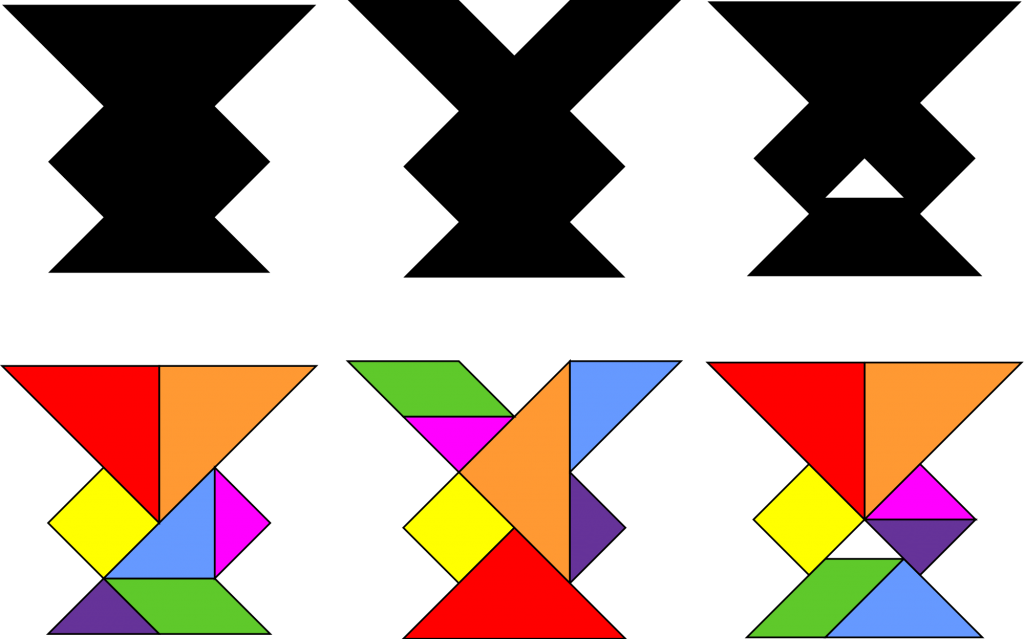
Tangram puzzles -- which originated in China and were brought to Europe during the early 19th century through trade routes -- use seven flat, geometric shapes to make silhouettes. While Tangrams are usually made out of wood, you can make sets for your class out of colored construction paper or felt.
Tangrams are an excellent tool for learners who enjoy being able to manipulate their work, and there are thousands of published problems to keep your students busy.

Similar to Sudoku, Str8ts challenges players to use their logic skills to place numbers in blank squares. The numbers might be consecutive, but can appear in any order. For example, a row could be filled with 5, 7, 4, 6 and 8 . This puzzle is better suited to older students, and can be used as a before-class or after-lesson activity to reinforce essential logic skills.
20. Mobius band
Is it magic? Is it geometry? Your students will be so amazed they might have a hard time figuring it out. Have them model the problem with strips of paper and see for themselves how it works in real life. With older students, use mobius bands to talk about geometry and surface area.
Why use math puzzles to teach?
Math puzzles encourage critical thinking.
Critical thinking and logic skills are important for all careers, not just STEM-related ones. Puzzles challenge students to understand structure and apply logical thinking skills to new problems.
A study from the Eurasia Journal of Mathematics, Science and Technology Education found that puzzles “develop logical thinking, combinatorial abilities, strengthen the capacity of abstract thinking and operating with spatial images, instill critical thinking and develop mathematical memory.”
All these skills allow young students to build a foundation of skills they’ll draw on for the rest of their lives, no matter what kind of post-secondary route they pursue.
They help build math fluency
Math games can help students build a basic understanding of essential math concepts, and as another study shows, can also help them retain concepts longer .
In the study, early elementary students gradually moved from using the “counting” part of their brains to complete math problems to the “remembering” part that adults use, suggesting math puzzles and repeated problems can help build the essential skill of math fluency .
Many of the math puzzles above allow students to practice essential addition, subtraction, multiplication and division skills, while advanced or modified problems can be used to introduce pre-algebraic concepts and advanced logic skills.
Math puzzles connect to existing curricula
No matter what curriculum you’re using, there’s a good chance it emphasizes problem-solving, critique and abstract thinking. This is especially true of Common Core math and similar curricula.

How Math Skills Impact Student Development
Math puzzles allow students to develop foundational skills in a number of key areas, and can influence how students approach math practically and abstractly. You can also tie them into strategies like active learning and differentiated instruction.
Instead of just teaching facts and formulas, math puzzles allow you to connect directly with core standards in the curriculum. You can also use them to provide a valuable starting point for measuring how well students are developing their critical thinking and abstract reasoning skills.
Tips for using math puzzles in the classroom
View this post on Instagram A post shared by Sarah Werstuik (@teach.plan.love)
Now that you’ve got some great math puzzles, it might be tricky to figure out how to best incorporate them into your classroom. Here are some suggestions for making the most of your lesson time:
Make sure the puzzles are the right level for your class
If the problems are too easy, students will get bored and disengage from the lesson. However, if the problems are too difficult to solve, there’s a good chance they’ll get frustrated and give up early.
There’s a time and a place
While fun math puzzles are a great way to engage your students in developing critical thinking skills, they’re not a tool for teaching important math concepts. Instead, use them to reinforce the concepts they’ve already learned.
Kitty Rutherford , a Mathematics Consultant in North Carolina, emphasizes that math puzzles and games shouldn’t be based solely on mental math skills , but on “conceptual understanding” that builds fluency over time. Math puzzles help build the essential balance between thinking and remembering.
Give them space to figure it out
Rachel Keen , from the Department of Psychology at the University of Virginia, conducted a study about problem-solving skills in preschoolers. She found that “playful, exploratory learning leads to more creative and flexible use of materials than does explicit training from an adult.”
Give your students space to struggle with a problem and apply their own solutions before jumping in to help them. If the problem is grade-appropriate and solvable, students will learn more from applying their own reasoning to it than just watching you solve it for them.
Model puzzles for your students
Use problems like the mobius strip to awe and amaze your students before drawing them into a larger discussion about the mathematical concept that it represents. If possible, make math puzzles physical using recycled craft supplies or modular tools.
Afterward, have a class discussion or put up math journal prompts. What methods did your students try? What tools did they use? What worked and what didn’t? Having students explicitly state how they got to their solution (or even where they got stuck) challenges them to examine their process and draw conclusions from their experience.
Final thoughts on math puzzles
Be aware that it might take a while to get all your students on board -- they could be hesitant about approaching unfamiliar problems or stuck in the unenthusiasm that math class often brings. Consider creating a weekly leaderboard in your classroom for the students that complete the most puzzles, or work through a few as a class before sending students off on their own.
Instead of yawns and bored stares , get ready to see eager participants and thoughtful concentration. Whether you choose to use them as an after-class bonus, a first day of school activity or as part of a targeted lesson plan, math puzzles will delight your students while also allowing them to develop critical skills that they’ll use for the rest of their lives.
What are you waiting for? Get puzzling!
Share this article
Table of Contents
Solve the hardest puzzle
Use Prodigy Math to boost engagement, offer differentiated instruction and help students enjoy math.
- Grades 6-12
- School Leaders
Win Daily Prizes in Our Very Merry Holiday Giveaway! 🎁
50 Math Brain Teasers (With Answers) for Every Age
When does 9 + 5 = 2?

There’s no better way to encourage outside-the-box thinking than math brain teasers! They’re usually much more about using logic than being a math whiz, so everyone will need to think creatively. Here are some of our favorite math brain teasers for students of all ages, which are perfect for bell ringers, extra credit, or to fill the last few minutes at the end of class.
Plus, click the button below to receive a Google Slideshow with all of our math brain teasers in an easy-to-present format!
Our 50 Math Brain Teasers
1. using only addition, add eight 8s to get the number 1,000..
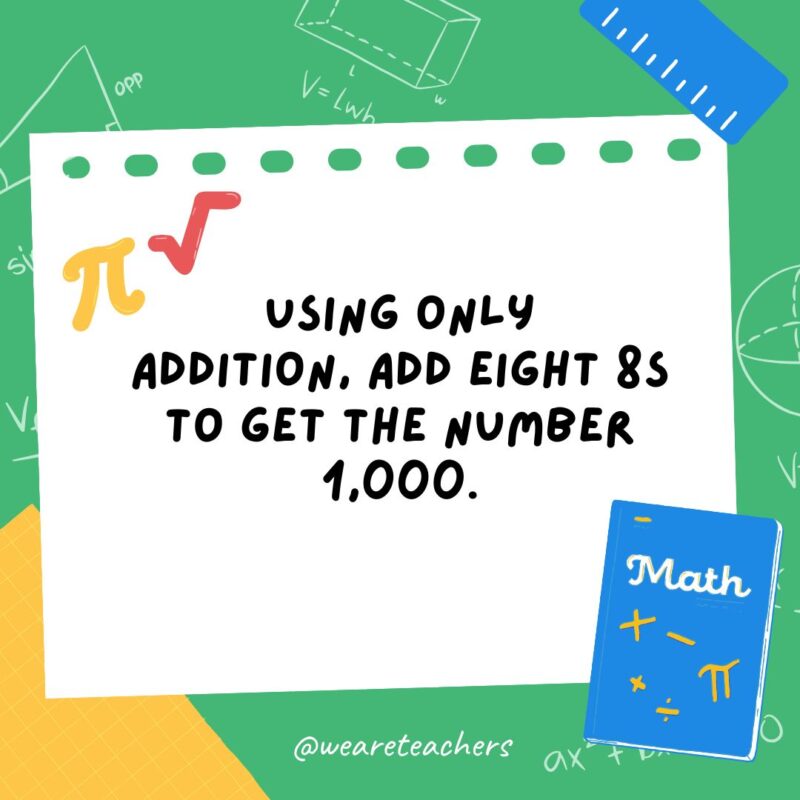
Answer: 888 + 88 + 8 + 8 + 8 = 1,000.
2. Two years ago, I was three times as old as my brother was. In three years, I will be twice as old as my brother. How old is each of us now?
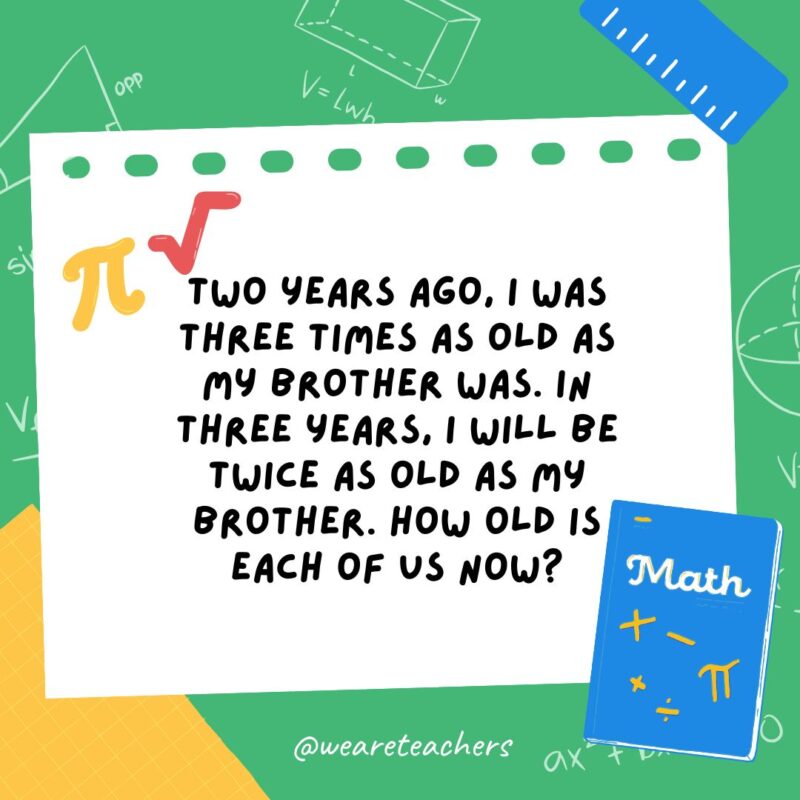
Answer: The older brother is 17, and the younger brother is 7.
3. If a hen and a half lays an egg and a half in a day and a half, how many eggs will half a dozen hens lay in half a dozen days?
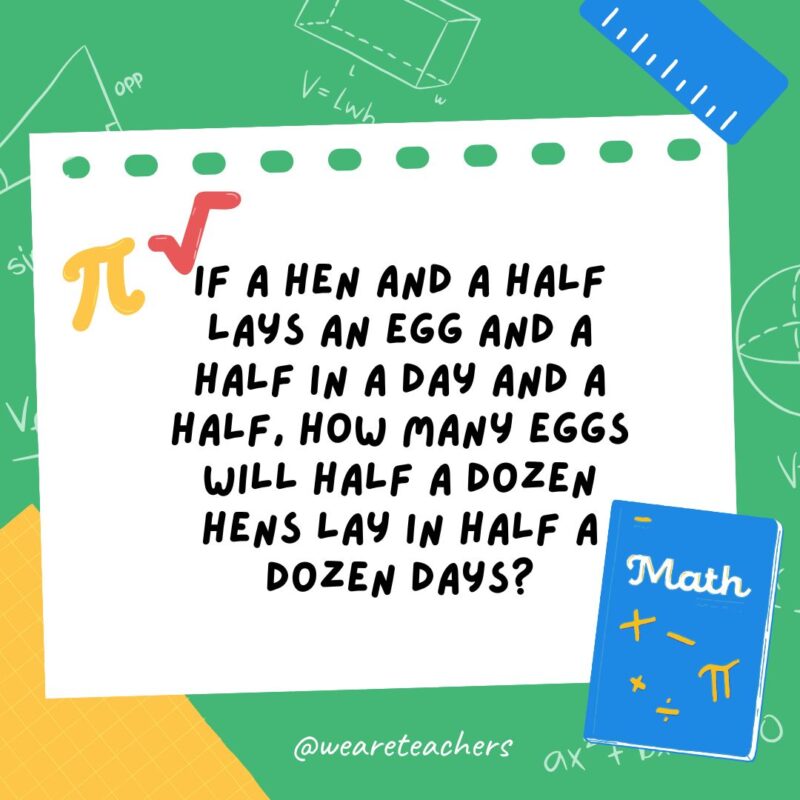
Answer: 2 dozen, or 24 eggs.
4. When does 9 + 5 = 2?

Answer: When you’re telling time. 9:00 + 5 hours = 2:00.
5. A farmer had 17 sheep. All but 9 of them ran away. How many sheep does she have left?

6. A boy is 2 years old. His brother is half as old as him. When the first boy is 100, how old will his brother be?

Answer: 99.
7. Use the numbers 2, 3, 4, and 5 and the symbols + and = to make a true math equation.

Answer: 2 + 5 = 3 + 4.
8. If 3 cats can catch 3 bunnies in 3 minutes, how long will it take 100 cats to catch 100 bunnies?

Answer: 3 minutes. ADVERTISEMENT
9. Mr. Lee has 4 daughters. Each of his daughters has 1 brother. How many children does Mr. Lee have?
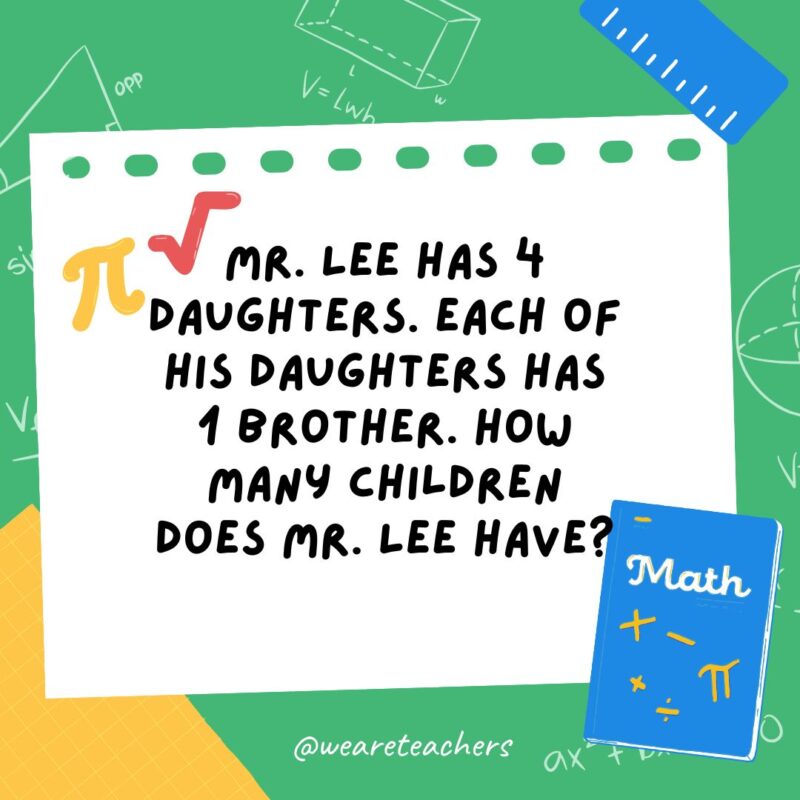
Answer: 5 (All of the daughters have the same brother.)
10. What single digit appears most frequently between and including the numbers 1 and 1,000?

11. Which weighs more: 16 ounces of feathers or a pound of solid gold?
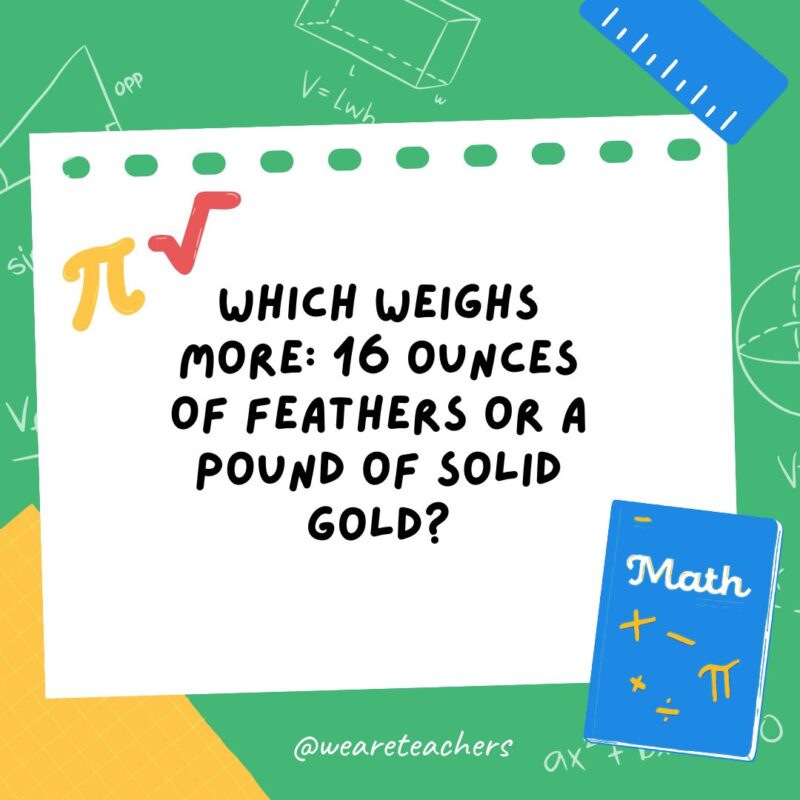
Answer: They weigh the same. 16 ounces = 1 pound, no matter what material is being weighed.
12. Jake bought a pair of shoes and a shirt, which cost a total of $150. The shoes cost $100 more than the shirt. How much was each item?
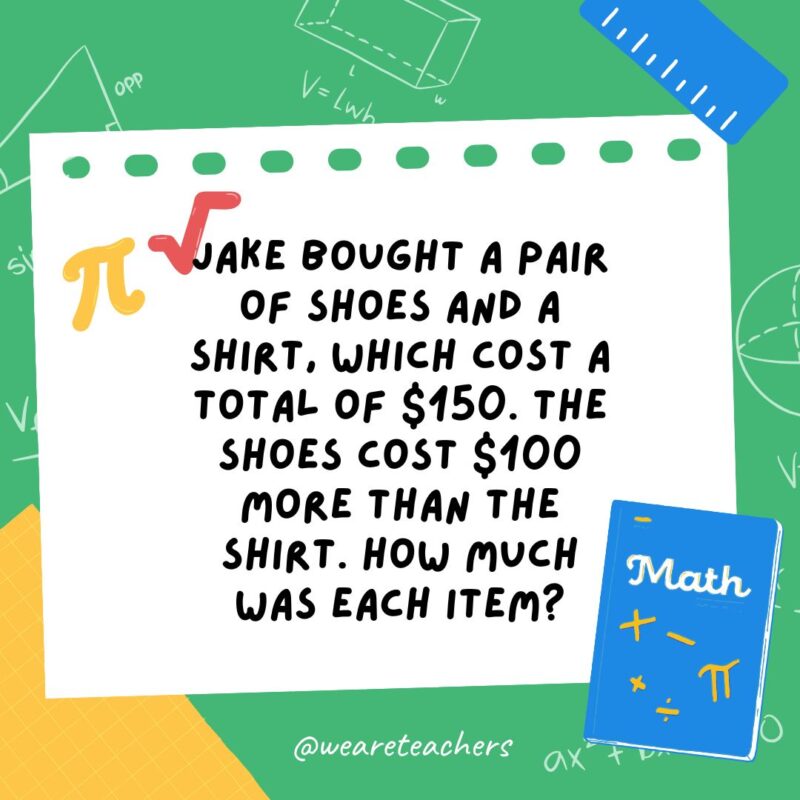
Answer: The shoes cost $125, the shirt $25.
13. You have two coins that total 30 cents. One of them is not a nickel. What are the two coins?

Answer: A quarter and a nickel. (Only ONE of the coins is not a nickel!)
14. A + B + C = D, and A x B x C = D. What numbers make these two equations true?

Answer: A = 1, B = 2, C = 3, and D = 6.
15. Solve this in your head (no writing it down!). Take 1,000 and add 40 to it. Add another 1,000. Now add 30. Add another 1,000. Now add 20. Add another 1,000. Now add 10. What is the total?
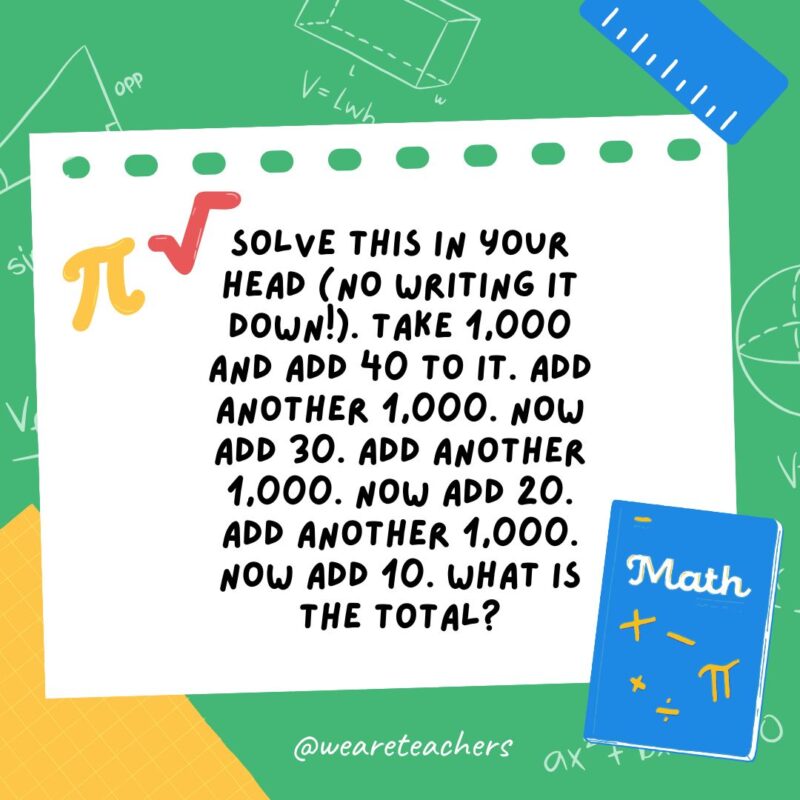
Answer: 4,100.
16. Grandmother died and left half her money to her granddaughter and half of that amount to her grandson. She left a sixth to her brother, and the remainder, $1,000, to the animal shelter. How much did she leave altogether?
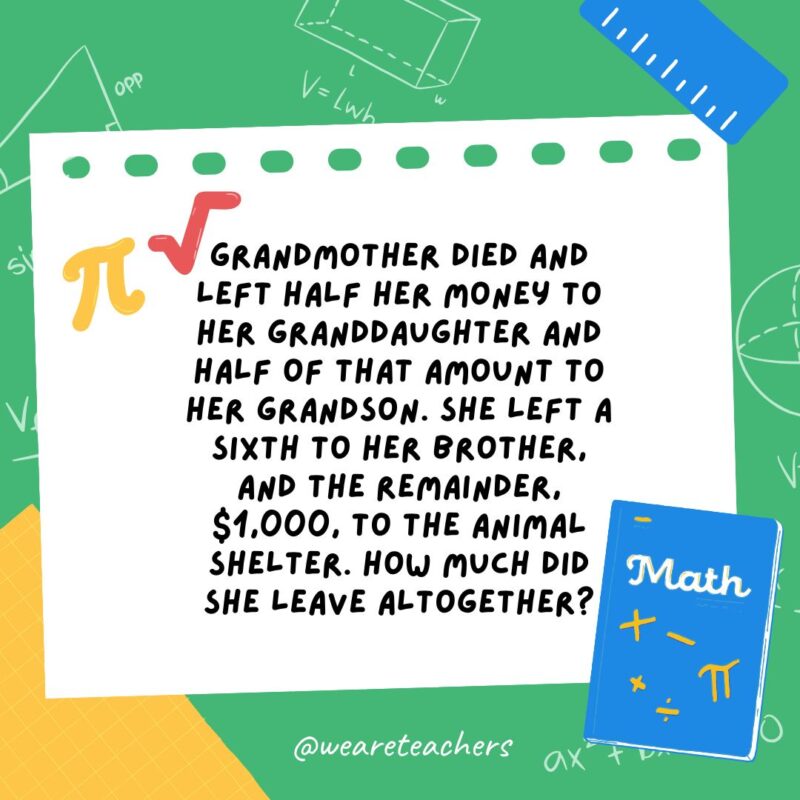
Answer: $12,000.
17. Your sock drawer contains 18 white socks and 18 blue socks. Without looking, what is the smallest number of socks you should take out to guarantee a matching pair?
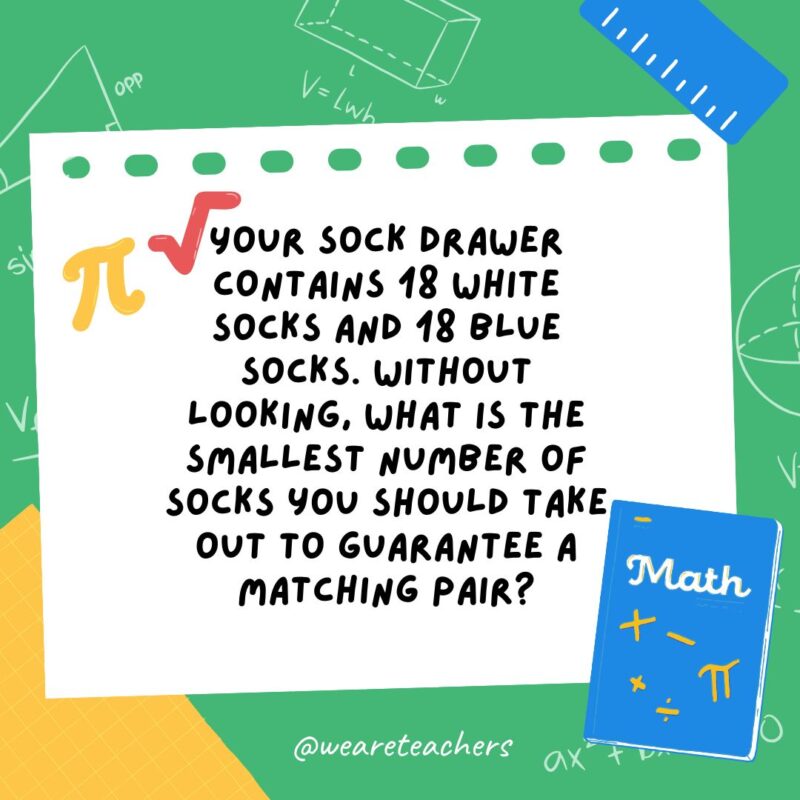
18. You planted sunflower seeds in your garden. Every day, the number of flowers doubles. If it takes 52 days for the flowers to fill the garden, how many days would it take for them to fill half the garden?

Answer: 51.
19. There are 100 houses in the neighborhood where Alex and Dev live. Alex’s house number is the reverse of Dev’s house number. The difference between their house numbers ends with 2. What are their house numbers?
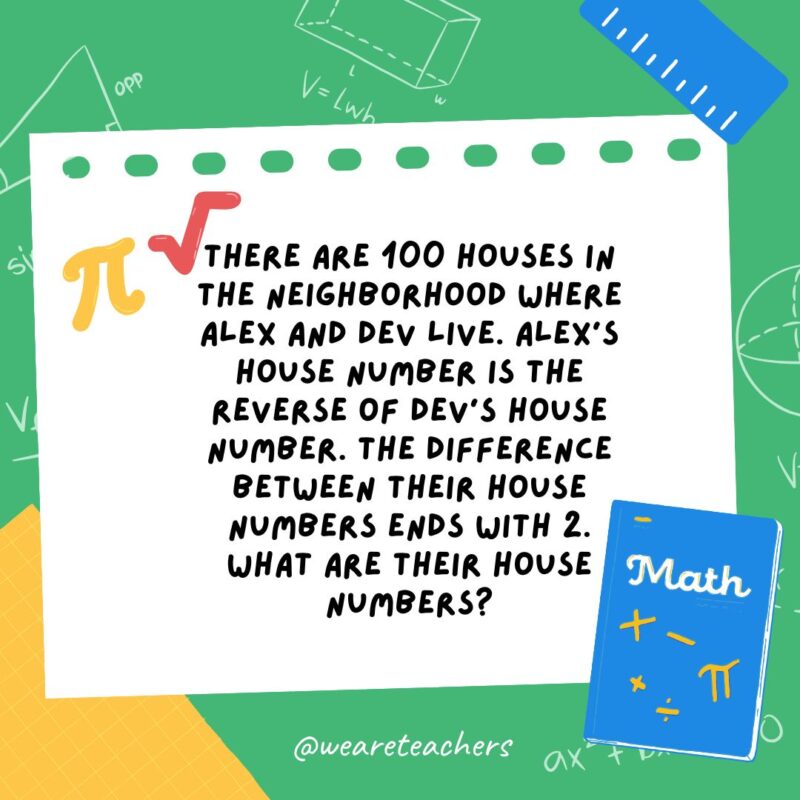
Answer: 19 and 91.
20. What can you place between 8 and 9 to make the outcome greater than 8 but less than 9?

Answer: A decimal (8.9 is greater than 8 but less than 9).
21. Multiply this number with any other number and you will get the same answer every time. What is the number?
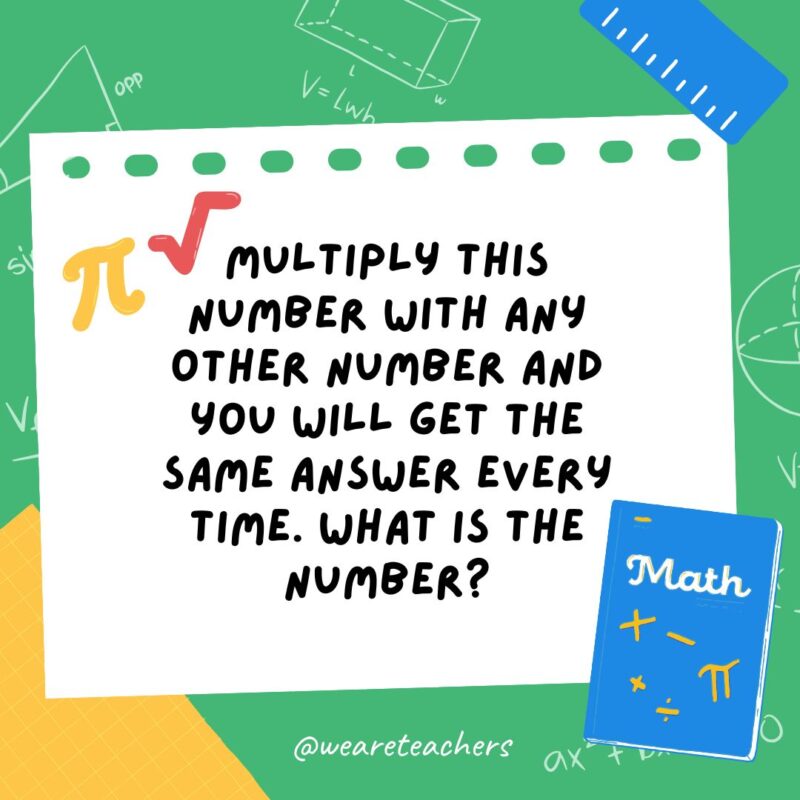
Answer: Zero.
22. If there are 6 oranges in a basket and you take out 4, how many oranges do you have?
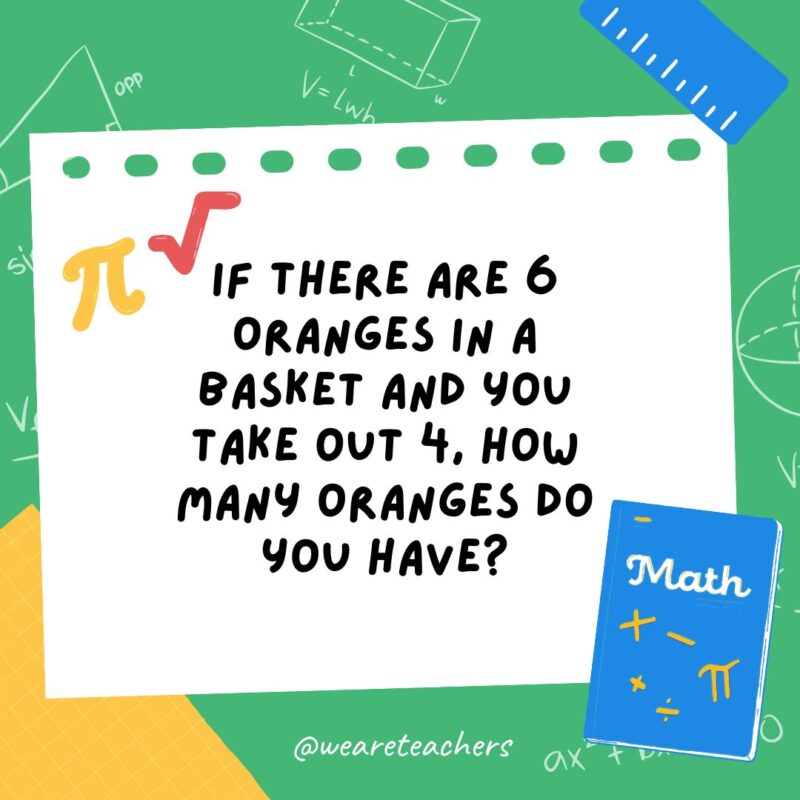
Answer: 4 (You took 4 oranges, so you have 4 oranges!)
23. There are 8 apples in a basket. Eight people each take 1 apple, but there is still 1 apple in the basket. How can this be?

Answer: The 8th person took the basket with 1 apple still in it.
24. Multiply all the numbers on the number pad of a phone. What is the total?

Answer: Zero (Phone number pads include the numbers 0-9.)
25. There are 7 kids in the Garcia family, each born 2 years apart. If the eldest Garcia child is 19, how old is the youngest Garcia child?

26. Two mothers and 2 daughters each had 1 egg for breakfast, but they only ate 3 eggs all together. How can this be?
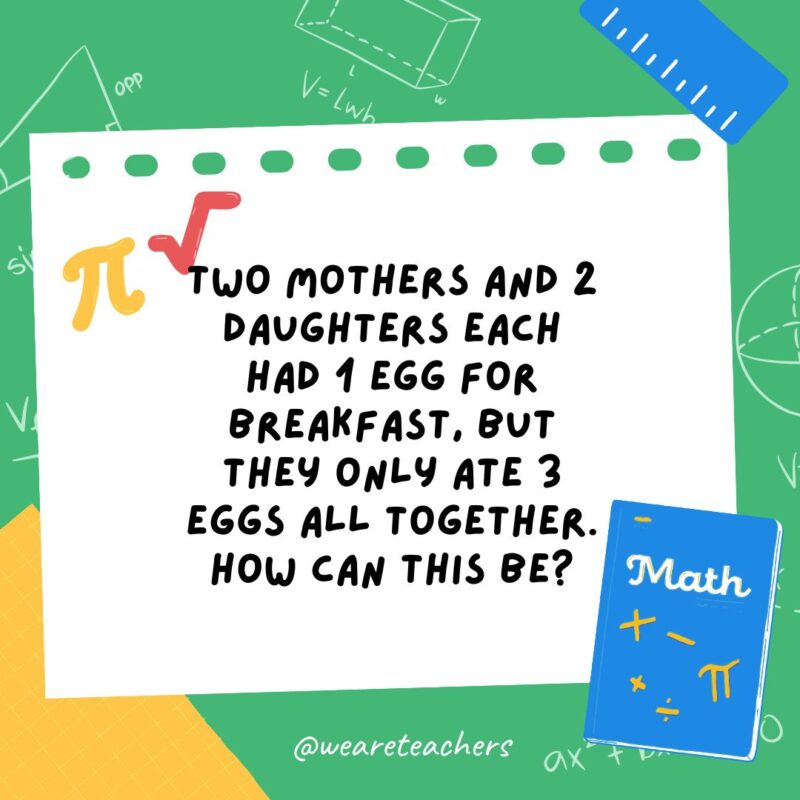
Answer: There were only 3 people—a grandmother, her daughter, and her granddaughter.
27. A 300-foot train traveling 300 feet per minute must travel through a 300-foot-long tunnel. How long will it take the train to travel through the tunnel?

Answer: 2 minutes. (It takes the front of the train 1 minute, and the rest of the train will take 1 more minute to clear the tunnel.)
28. I am a three-digit number. My second digit is four times greater than the third digit. My first digit is three less than my second digit. What number am I?
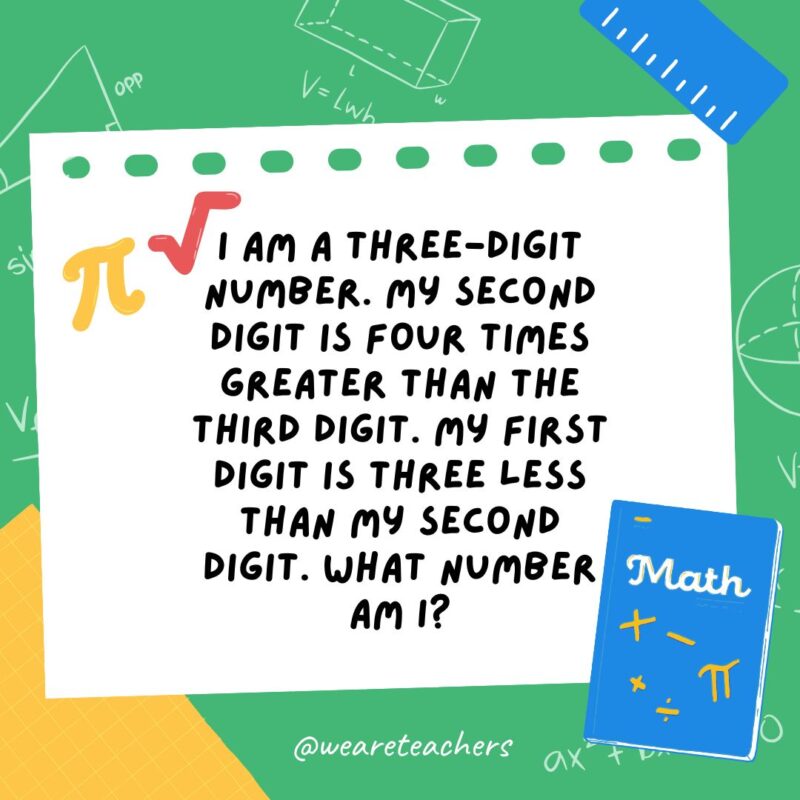
Answer: 141.
29. Tom was asked to paint numbers outside 100 apartments, which means he will have to paint numbers 1 through 100. How many times will he have to paint the number 8?
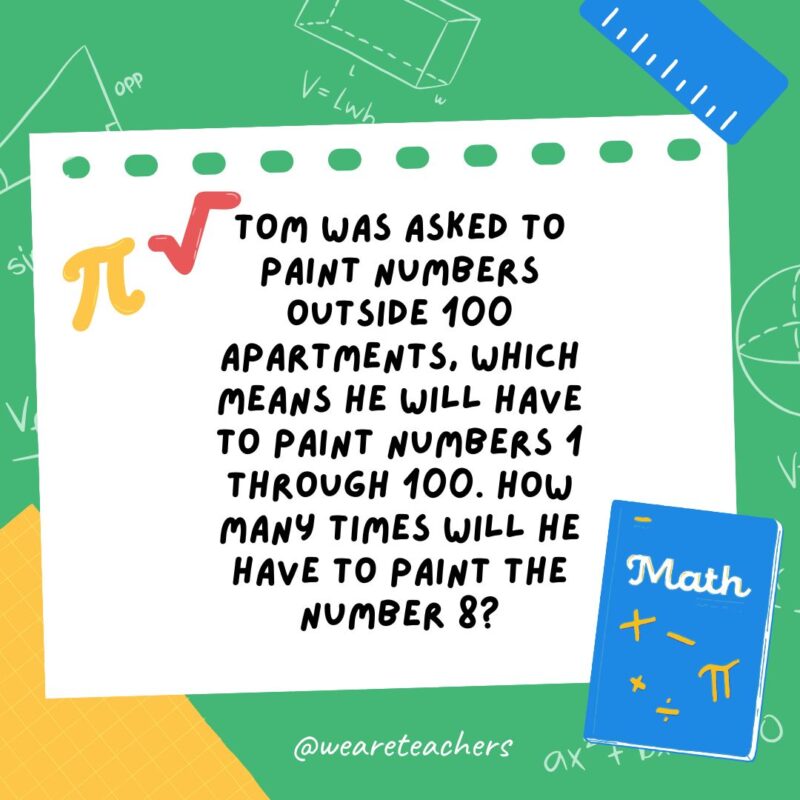
Answer: 20 times (8, 18, 28, 38, 48, 58, 68, 78, 80, 81, 82, 83, 84, 85, 86, 87, 88 [two 8s], 89, 98).
30. Ellie works at the aquarium. When she tries to put each turtle in its own tank, she has one turtle too many. But if she puts two turtles per tank, she has one tank too many. How many turtles and how many tanks does Ellie have?

Answer: Ellie has 3 tanks and 4 turtles.

31. If eggs cost 12 cents a dozen, how many eggs can you get for $1?

Answer: 100 eggs (The eggs cost 1 penny each.)
32. If you toss a coin 100 times and it lands heads up every time, what is the chance it will land heads up on your next throw?

Answer: 50/50 (The previous tosses don’t make any difference; you always have an equal chance of heads or tails.)
33. You’re visiting a clothing store that has a strange way of pricing items. A vest costs $20, socks cost $25, a tie costs $15, and a blouse costs $30. You want to buy some underwear. How much will it cost?
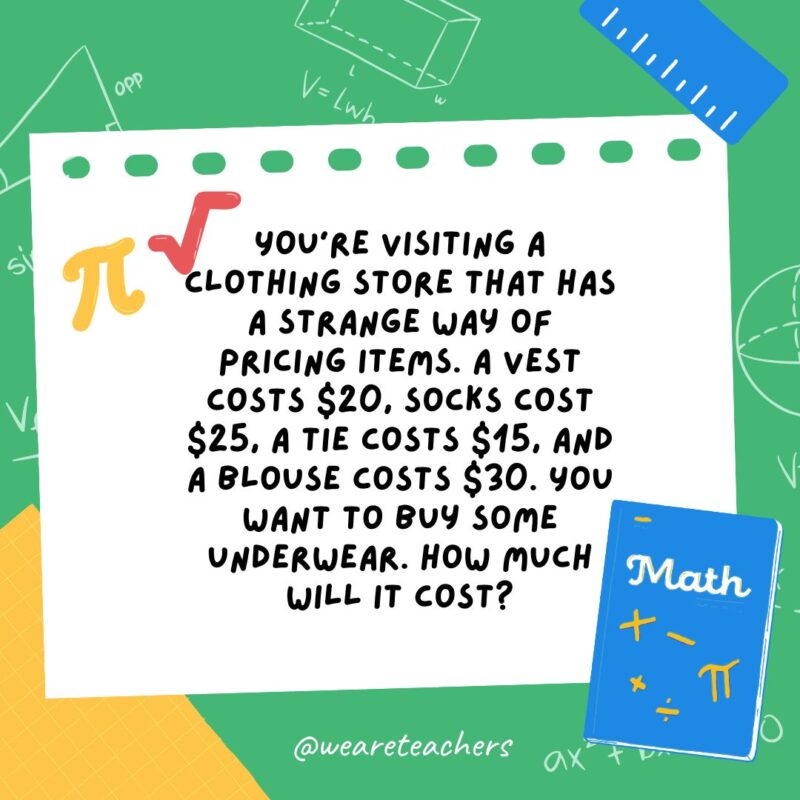
Answer: $45. Items cost $5 for each letter used to spell the word.
34. How can you make this equation correct: 81 x 9 = 801?

Answer: Turn it upside down: 108 = 6 x 18.
35. You’re planning to spend your birthday money taking some friends to the movies. Is it cheaper to take 1 friend to the movies twice or 2 friends to the movies at the same time?

Answer: Take 2 friends at the same time, so you’ll only buy 3 tickets total. If you take 1 friend twice, you’ll need to buy yourself a ticket each time, for a total of 4 tickets.
36. Each day, a snail climbs 3 feet up a wall, but each night it slips 2 feet back down while it sleeps. If the wall is 30 feet high, how many days will it take for the snail to reach the top?

Answer: 28 days. Each day, the snail makes a 1 foot gain, bringing it to 27 feet by the 27th day. On the 28th day, it will climb the last 3 feet and reach the top.
37. Divide 40 by half and add 10. What’s the result?
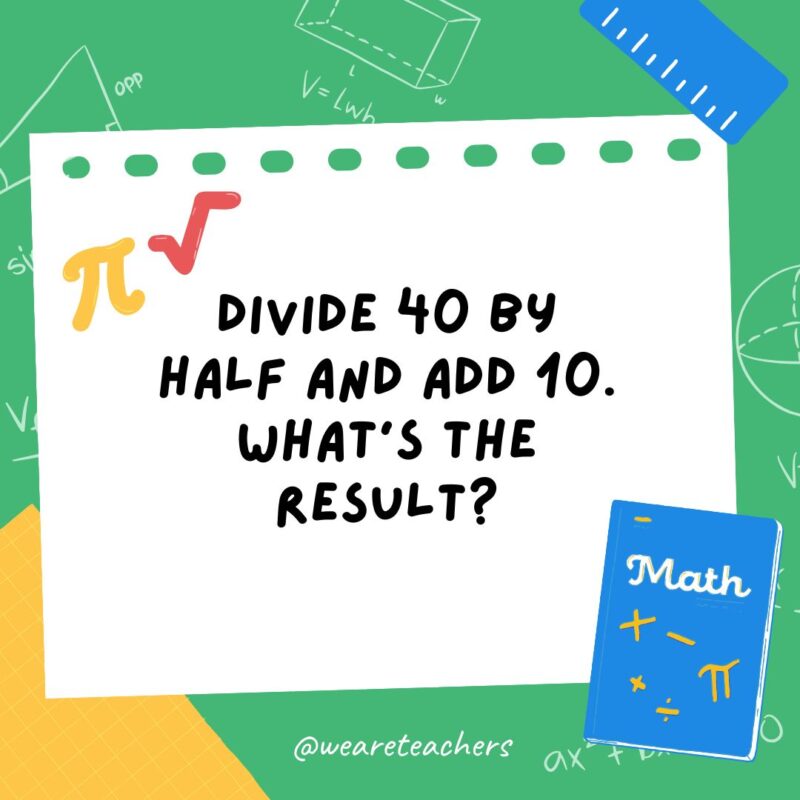
Answer: 90. The instruction says to divide by half, not to divide in half. In other words, the equation is 40 ÷ .5 = 80 + 10 = 90.
38. Add me to myself and multiply by 4. Divide me by 8 and you will have me once more. What number am I?

Answer: This works for any number!
39. Lin is four times as old as her daughter Rosa. In 20 years, Lin will be twice as old as her daughter. How old are Lin and Rosa now?

Answer: Lin is 40, and Rosa is 10.
40. A box holds 13 blue marbles, 13 red marbles, and 13 green marbles. If you’re unable to see into the box, what is the minimum number of marbles you need to take out to ensure you have one of every color?
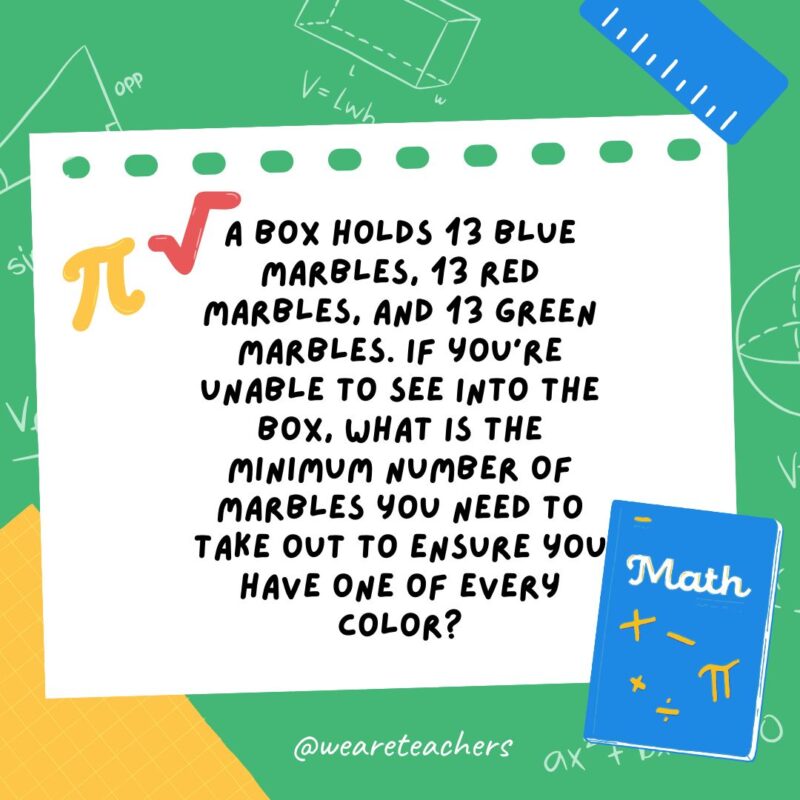
Answer: 27. You might need to take out every one of two colors of marbles (26) before pulling one of the third color (+1).
41. A store is offering a bat and ball for a total of $1.10. The bat costs $1 more than the ball. How much does each item cost separately?

Answer: The ball costs 5 cents, and the bat costs $1.05.
42. Find two numbers whose squares add up to 100. (Neither number is zero.)

Answer: 8 and 6 (64 + 36 = 100).
43. Miguel, Sara, and Olive share a box of 120 M&Ms. Miguel eats half the candy, Sara eats one-third, and Olive eats one-tenth. How many M&Ms are left?
- math brain teasers
Answer: 8. Miguel eats 60, Sara eats 40, and Olive eats 12. This leaves 8 pieces of candy uneaten.
44. What is unique about this number: 8,549,176,320?
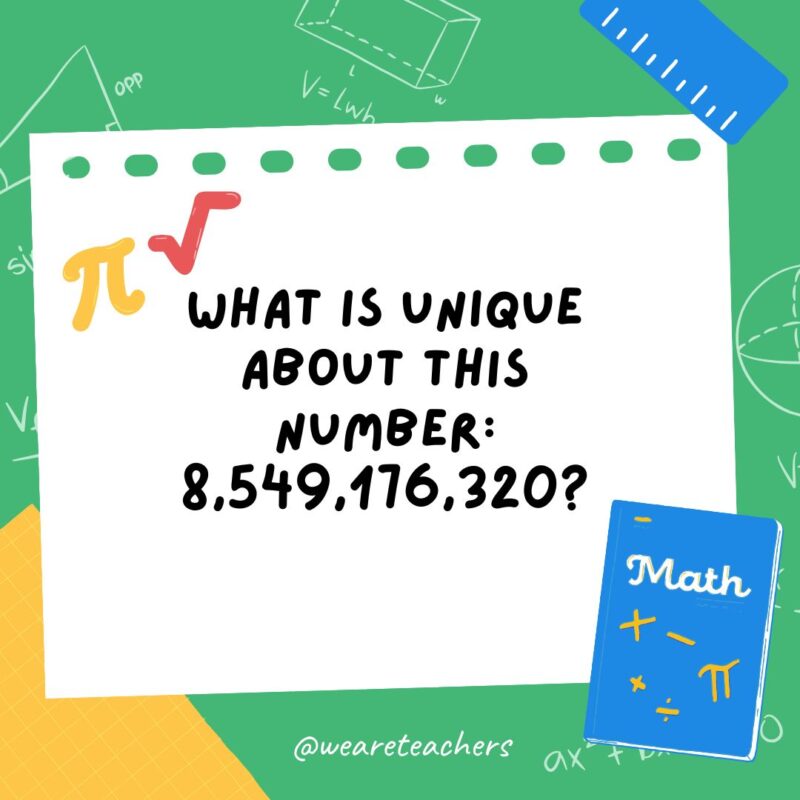
Answer: When spelled out as words, it contains the numbers 0 to 10 in alphabetical order. (Eight, five, four, etc.)
45. Arrange the numbers 1 to 9 in a 3 x 3 grid such that the sum of each row, column, and diagonal is the same.

Answer: Row One: 8 3 4, Row Two: 1 5 9, Row Three: 6 7 2.
46. A rectangle has a perimeter of 24 inches. If the length is twice the width, what are the dimensions of the rectangle?
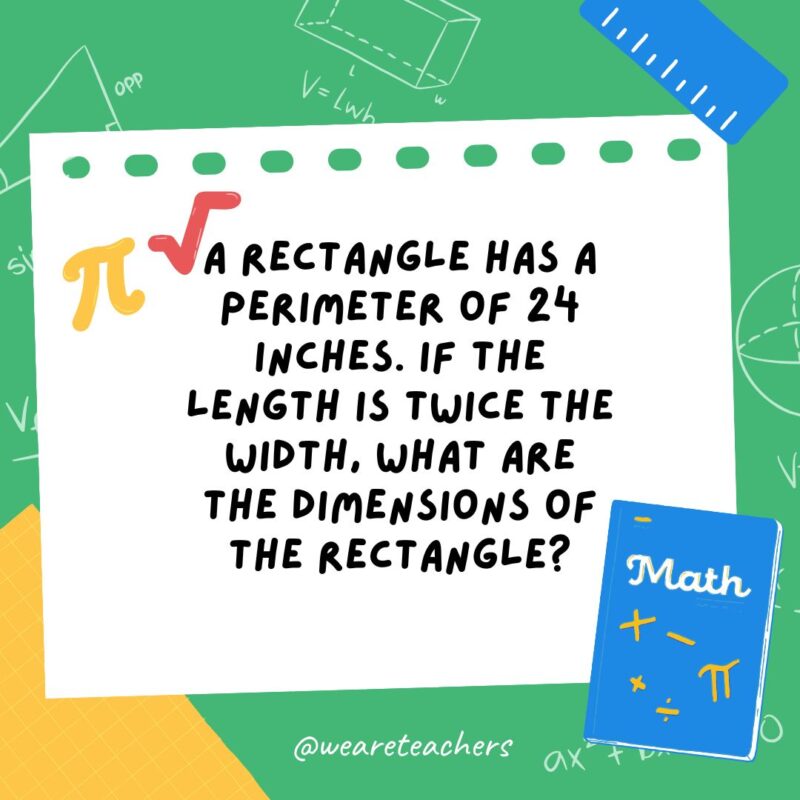
Answer: Width = 4 inches, length = 8 inches.
47. I am a four-digit number (ABCD). When you multiply me by 4, the answer is the same four-digit number in reverse (DCBA). What number am I?

Answer: 2,178.
48. What is the next number in this series? 7,645 5,764 4,576 _______.
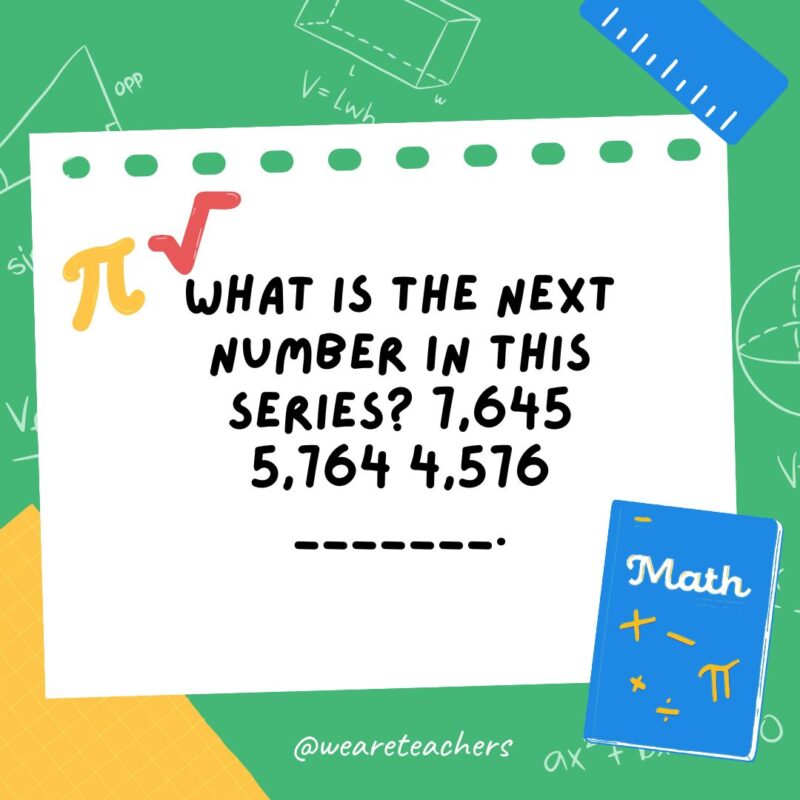
Answer: 6,457 (Move the final digit to the beginning each time.)
49. A triangle has three angles that are all square numbers. What are the angles of this triangle?
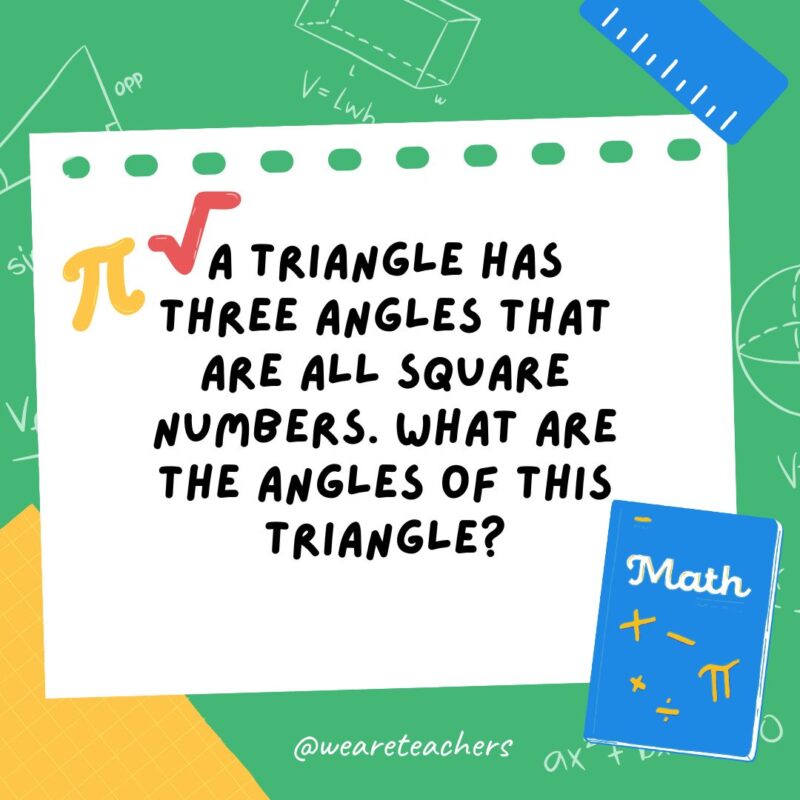
Answer: 16 degrees, 64 degrees, and 100 degrees.
50. What is the smallest whole number that, when written out in words, uses all the vowels exactly once?
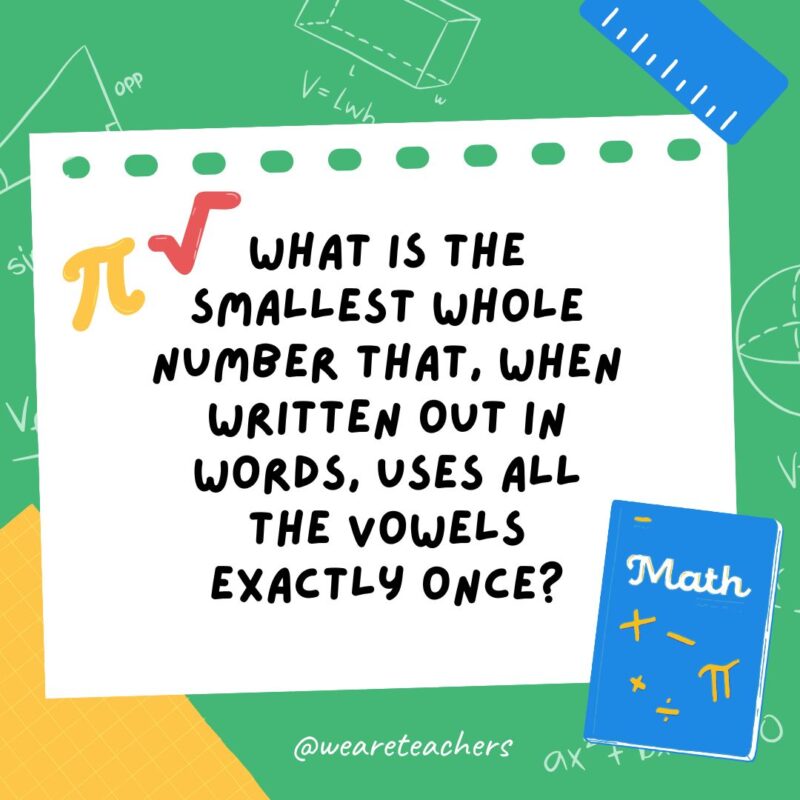
Answer: Five thousand.
Get my Google Slides presentation of math brain teasers!
If you loved our math brain teasers, click the button below to receive your own copy. The brain teasers are formatted to share with your classroom easily.
Did we miss one of your favorite math brain teasers? Come share your conundrums in the We Are Teachers HELPLINE group on Facebook .
If you love these math brain teasers, don’t miss 15 math puzzles and number tricks to wow your students ., you might also like.

15 Magical Math Puzzles and Number Tricks To Wow Your Students
Think of a number, any number... Continue Reading
Copyright © 2024. All rights reserved. 5335 Gate Parkway, Jacksonville, FL 32256
Mastery-Aligned Maths Tutoring
“The best thing has been the increase in confidence and tutors being there to deal with any misunderstandings straight away."
FREE daily maths challenges
A new KS2 maths challenge every day. Perfect as lesson starters - no prep required!

25 Fun Maths Problems For KS2 And KS3 (From Easy To Very Hard!)
Fun maths problems are one of the things mathematicians love about the subject; they provide an opportunity to apply mathematical knowledge, logic and problem solving skills all at once. In this article, we’ve compiled 25 fun maths problems, each covering various topics and question types. They’re aimed at students in KS2 & KS3. We’ve categorised them as:
Maths word problems
Maths puzzles, fraction problems, multiplication and division problems, geometry problems, problem solving questions, maths puzzles are everywhere, how should teachers use these maths problems.
Teachers could make use of these maths problem solving questions in a number of ways, such as:
- embed into a relevant maths topic’s teaching.
- settling tasks at the beginning of lessons.
- break up or extend a maths worksheet.
- keep students thinking mathematically after the main lesson has finished.
Some are based on real life or historical maths problems, and some include ‘bonus’ maths questions to help to extend the problem solving fun! As you read through these problems, think about how you could adjust them to be relevant to your students or to practise different skills.
These maths problems can also be used as introductory puzzles for maths games such as those introduced at the following links:
- KS2 maths games
- KS3 maths games
Need more support teaching reasoning, problem solving and planning for depth ? Read here for free CPD for you and your team of teachers.
1. Home on time – easy
Type: Time, Number, Addition
A cinema screening starts at 14:35. The movie lasts for 2 hours, 32 minutes after 23 minutes of adverts. It took 20 minutes to get to the cinema. What time should you tell your family that you’ll be home?
Answer: 17:50
2. A nugget of truth – mixed
Type: Times Tables, Multiplication, Multiples, Factors, Problem Solving
Chicken nuggets come in boxes of 6, 9 or 20, so you can’t order 7 chicken nuggets. How many other impossible quantities can you find (not including fractions or decimals)?
Answer: 1, 2, 3, 4, 5, 7, 8, 10, 11, 13, 14, 16, 17, 19, 22, 23, 25, 28, 31, 34, 37, or 43
There is actually a theorem which can be used to prove that every integer quantity greater than 43 can be ordered.
3. A pet problem – mixed
Type: Number, Problem Solving, Forming and Solving Equations, Simultaneous Equations, Algebra
Eight of my pets aren’t dogs, five aren’t rabbits, and seven aren’t cats. How many pets do I have?
Answer: 10 pets (5 rabbits, 3 cats, 2 dogs)
4. The price of things – mixed
Type: lateral thinking problem
A mouse costs £10, a bee costs £15, and a spider costs £20. How much does a duck cost? Answer: £5 (£2.50 per leg)
Looking for more word problems, solutions and explanations? Read our article on word problems for primary school.

25 Fun Maths Problems - Printable
Download a printable version of these fun maths problems together with answers and mark scheme.
5. A dicey maths challenge – easy
Type: Place value, number, addition, problem solving
Roll three dice to generate three place value digits. What’s the biggest number you can make out of these digits? What’s the smallest number you can make?
Add these two numbers together. What do you get?
Answer: In most cases, 1,089.
Bonus: Who got a different result? Why?
6. PIN problem solving – mixed
Type: Logic, problem solving, reasoning
I’ve forgotten my PIN. Six incorrect attempts locks my account: I’ve used five! Two digits are displayed after each unsuccessful attempt: “2, 0” means 2 digits from that guess are in the PIN, but 0 are in the right place.
What should my sixth attempt be?

Answer: 6347
7. So many birds – mixed
Type: Triangular Numbers, Sequences, Number, Problem Solving
On the first day of Christmas my true love gave me one gift. On the second day they gave me another pair of gifts plus a copy of what they gave me on day one. On day 3, they gave me three new gifts, plus another copy of everything they’d already given me. If they keep this up, how many gifts will I have after twelve days?
Answer: 364
Bonus: This could be calculated as 1 + (1 + 2) + (1 + 2 + 3) + … but is there an easier way? What percentage of my gifts do I receive on each day?
8. I 8 sum maths questions – mixed
Type: Number, Place Value, Addition, Problem Solving, Reasoning
Using only addition and the digit 8, can you make 1,000? You can put 8s together to make 88, for example.
Answer: 888 + 88 + 8 + 8 + 8 = 1,000 Bonus: Which other digits allow you to get 1,000 in this way?
9. Quizzical – easy
Type: Fractions, Adding Fractions, Equivalent Fractions, Fractions to Percentages
4 friends entered a maths quiz. One answered \frac{1}{5} of the maths questions, one answered \frac{1}{10} , one answered \frac{1}{4} , and the other answered \frac{4}{25} . What percentage of the questions did they answer altogether?
Answer: 71%
10. Ancient problem solving – mixed
Type: Fractions, Reasoning, Problem Solving
Ancient Egyptians only used unit fractions (like \frac{1}{2} , \frac{1}{3} or \frac{1}{4} ). For \frac{2}{3} , they’d write \frac{1}{3} + \frac{1}{3} . How might they write \frac{5}{8} ?
Answer: \frac{1}{8} + \frac{1}{8} + \frac{1}{8} + \frac{1}{8} + \frac{1}{8} is correct. So is \frac{1}{2} + \frac{1}{8} .
Bonus: Which solution is better? Why? Can you find any more? What if subtractions are allowed?
Learn more about unit fractions here
11. everybody wants a pizza the action – hard.
An infinite number of mathematicians buy pizza. The first wants \frac{1}{2} pizza. The second wants \frac{1}{4} pizza. The third & fourth want \frac{1}{8} and \frac{1}{16} each, and so on. How many pizzas should they order?
Answer: 1 Each successive mathematician wants a slice that is exactly half of what is left:
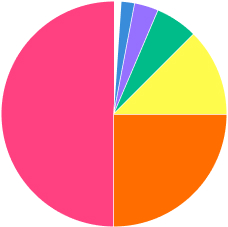
12. Shade it black – hard
Type: Fractions, Reasoning, Problem Solving What fraction of this image is shaded black?
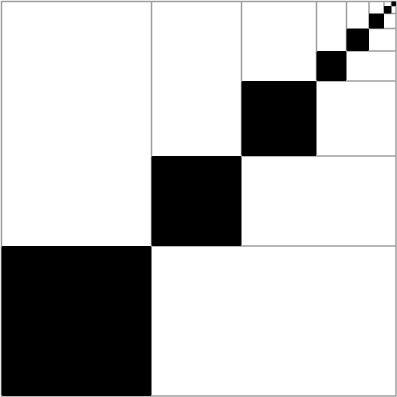
Answer: \frac{1}{3}
Look at the L-shaped part made up of two white and one black squares: \frac{1}{3} of this part is shaded. Zoom in on the top-right quarter of the image, which looks exactly the same as the whole image, and use the same reasoning to find what fraction of its L-shaped portion is shaded. Imagine zooming in to do the same thing again and again…
13. Giving is receiving – easy
Type: Number, Reasoning, Problem Solving
5 people give each other a present. How many presents are given altogether?
14. Sharing is caring – mixed
I have 20 sweets. If I share them equally with my friends, there are 2 left over. If one more person joins us, there are 6 sweets left. How many friends am I with?
Answer: 6 people altogether (so 5 friends!)
15. Times tables secrets – mixed
Type: Area, 2D Shape, Rectangles
Here are 77 letters:
BYHRCGNGNEOEAAHGHGCURPUTSTSASHHSBOBOREOPEEMEMEELATPEPEFADPHLTLTUT IEEOHOHLENRYTITIIAGBMTNTNFCGEIIGIG
How many different rectangular grids could you arrange all 77 letters into?
Answer: Four: 1⨉77, 77⨉1, 11⨉7 & 7⨉11. If the letters are arranged into one of these, a message appears, reading down each column starting from the top left.
Bonus: Can you find any more integers with the same number of factors as 77? What do you notice about these factors (think about prime numbers)? Can you use this system to hide your own messages?
16. Laugh it up – hard
Type: Multiples, Lowest Common Multiple, Times Tables, Division, Time
One friend jumps every \frac{1}{3} of a minute. Another jumps every 31 seconds. When will they jump together? Answer: After 620 seconds

17. Pictures of matchstick triangles – easy
Type: 2D Shapes, Equilateral Triangles, Problem Solving, Reasoning
Look at the matchsticks arranged below. How many equilateral triangles are there?

Answer: 13 (9 small, 3 medium, 1 large)
Bonus: What if the biggest triangle only had two matchsticks on each side? What if it had four?
18. Dissecting squares – mixed
Type: Reasoning, Problem Solving
What’s the smallest number of straight lines you could draw on this grid such that each square has a line going through it?

19. Make it right – mixed
Type: Pythagoras’ theorem
This triangle does not agree with Pythagoras’ theorem.
Adding, subtracting, multiplying or dividing each of the side lengths by the same integer can fix it. What is the integer?
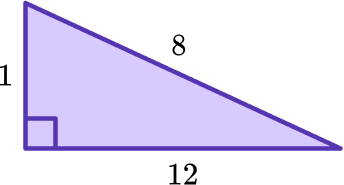
Answer: 3
8 – 3 = 5
The new side lengths are 3, 4 and 5 and 32 + 42 = 52.
20. A most regular maths question – hard
Type: Polygons, 2D Shapes, tessellation, reasoning, problem-solving, patterns
What is the regular polygon with the largest number of sides that will self-tessellate?
Answer: Hexagon.
Regular polygons tessellate if one interior angle is a factor of 360°. The interior angle of a hexagon is 120°. This is the largest factor less than 180°.
21. Pleased to meet you – easy
Type: Number Problem, Reasoning, Problem-Solving
5 people meet; each shakes everyone else’s hand once. How many handshakes take place?
Person A shakes 4 people’s hands. Person B has already shaken Person A’s hand, so only needs to shake 3 more, and so on.
Bonus: How many handshakes would there be if you did this with your class?
22. All relative – easy
Type: Number, Reasoning, Problem-Solving
When I was twelve my brother was half my age. I’m 40 now, so how old is he?
23. It’s about time – mixed
Type: Time, Reasoning, Problem-Solving
When is “8 + 10 = 6” true?
Answer: When you’re telling the time (8am + 10 hours = 6pm)
24. More than a match – mixed
Type: Reasoning, Problem-Solving, Roman Numerals, Numerical Notation
Here are three matches:
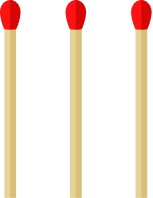
How can you add two more matches, but get eight? Answer: Put the extra two matches in a V shape to make 8 in Roman Numerals:

25. Leonhard’s graph – hard
Type: Reasoning, Problem-Solving, Logic
Leonhard’s town has seven bridges as shown below. Can you find a route around the town that crosses every bridge exactly once?

Answer: No!
This is a classic real life historical maths problem solved by mathematician Leonhard Euler (rhymes with “boiler”). The city was Konigsberg in Prussia (now Kaliningrad, Russia). Not being able to find a solution is different to proving that there aren’t any! Euler managed to do this in 1736, practically inventing graph theory in the process.
Many of these 25 maths problems are rooted in real life, from everyday occurrences to historical events. Others are just questions that might arise if you say “what if…?”. The point is that although there are many lists of such problem solving maths questions that you can make use of, with a little bit of experience and inspiration you could create your own on almost any topic – and so could your students.
For a kick-starter on creating your own maths problems, read our article on KS3 maths problem solving .
Looking for additional support and resources at KS3? You are welcome to download any of the secondary maths resources from Third Space Learning’s resource library for free. There is a section devoted to GCSE maths revision with plenty of maths worksheets and GCSE maths questions . There are also maths tests for KS3, including a Year 7 maths test , a Year 8 maths test and a Year 9 maths test For children who need more support, our maths intervention programmes for KS3 achieve outstanding results through a personalised one to one tuition approach.
DO YOU HAVE STUDENTS WHO NEED MORE SUPPORT IN MATHS?
Every week Third Space Learning’s specialist online maths tutors support thousands of students across hundreds of schools with weekly online 1 to 1 maths lessons designed to plug gaps and boost progress.
Since 2013 these personalised one to 1 lessons have helped over 169,000 primary and secondary students become more confident, able mathematicians.
Learn how the programmes are aligned to maths mastery teaching or request a personalised quote for your school to speak to us about your school’s needs and how we can help.
Related articles

Maths Problem Solving: Engaging Your Students And Strengthening Their Mathematical Skills

Free Year 7 Maths Test With Answers And Mark Scheme: Mixed Topic Questions

What Is A Number Square? Explained For Primary School Teachers, Parents & Pupils
What Is Numicon? Explained For Primary School Teachers, Parents And Pupils
FREE Guide to Maths Mastery
All you need to know to successfully implement a mastery approach to mathematics in your primary school, at whatever stage of your journey.
Ideal for running staff meetings on mastery or sense checking your own approach to mastery.
Privacy Overview

IMAGES
VIDEO
COMMENTS
Math and Logic Puzzles. If you REALLY like exercising your brain, figuring things 'round and 'round till you explode, then this is the page for you ! Whosoever shall solve these puzzles shall Rule The Universe!... or at least they should ...
Brain teasers, logic puzzles and math riddles give students challenges that encourage problem-solving and logical thinking. They can be used in classroom gamification , and to inspire students to tackle problems they might have previously seen as too difficult.
Are you looking for fun and engaging maths puzzles with answers for ages 12 and up? This collection of brain-bending maths puzzles with answers and hints is a great way to challenge yourself and develop your problem-solving skills.
Engage your elementary and middle school students with these fun math problems, suitable for individuals, pairs and small groups! Includes a range of challenge levels to engage all learners. Download Free Now!
Want to challenge students to think outside the box? Try these math brain teasers! They're perfect as bell ringers or enrichment activities.
Fun maths problems are one of the things mathematicians love about the subject; they provide an opportunity to apply mathematical knowledge, logic and problem solving skills all at once. In this article, we’ve compiled 25 fun maths problems, each covering various topics and question types.